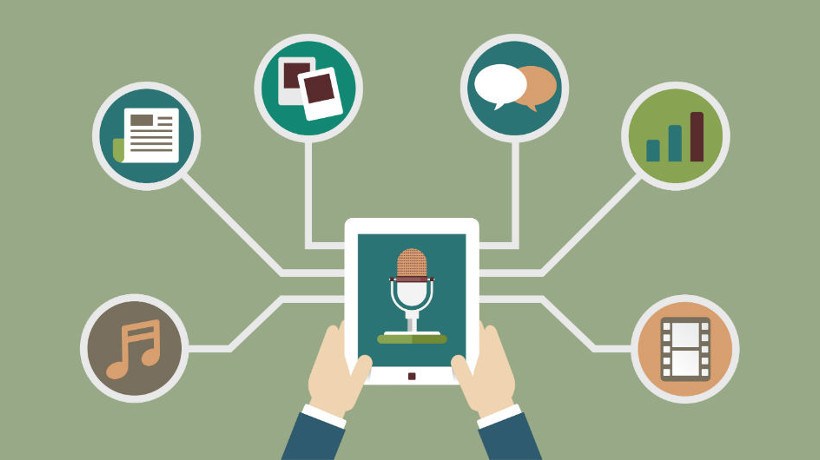How To Create Podcasts For eLearning
Podcasts are one of the most convenient eLearning tools that you can offer your audience. They can listen to an engaging online presentation, follow along with a tutorial, or build a skill while they sit in rush hour traffic. Whether you choose to upload them to a digital marketplace or embed them into your eLearning course design, podcasts give online learners the opportunity to immerse themselves in the subject matter from anywhere in the world. Here are 7 tips on how to successfully create podcasts for eLearning and integrate them into your eLearning experiences.
- Integrate your branding.
Podcasts have the capacity to reach far and wide, which is why it's always wise to integrate your branding. Mention your company name, website info, and any other contact information that a listener might need to learn about your organization. You should also identify a theme for your podcast series or channel. Choose a catchy name, tagline, and tone to create a sense of cohesiveness. Make sure that your branding message aligns with the subject matter or target audience. For example, a podcast for eLearning that is geared toward business professionals should be more authoritative, while a more casual audience might call for a conversational tone. Using the right editing software will allow you to integrate your branding easy while creating your podcast. - Develop a detailed outline.
Create a detailed outline or an eLearning storyboard for every podcast. If you are creating series you may want to develop several outlines in advance so that you don't repeat eLearning content. Decide which topics you are going to include in each episode and then brainstorm ideas around that central topic. For example, an episode that focuses on a work-related task can highlight every step involved, share the benefits of performing the task, and stress the real world applications. Then the next episode might explore a specific skill set that employees need in the workplace. All of your podcasts for eLearning should have a natural flow and transition into the installment. This keeps listeners coming back for more and prompts them to tune in next time. Make certain that your outline covers all of the topics you'll be discussing and has some degree of audience participation, such as asking compelling questions or soliciting their feedback. - Create reusable eLearning templates.
There are certain elements of your podcast for eLearning that you can reuse for every episode, such as the audio intro and sound effects. Create an eLearning template that you can repurpose each time to streamline your podcast production process. If you are going to be following the same eLearning script format, you can even create a master eLearning template and simply plug in the new information. Every now and then you should review your current eLearning templates and freshen them up. For example, you can update your intro, or add a tip section when the need arises. Keep in mind that the eLearning template is just a general guideline and you may need to make minor adjustments, depending on the subject matter. - Choose the right voice.
You may need to enlist the help of a professional voice over artist if you don't feel comfortable hosting the podcast. There are a variety of freelancing sites where you can find voiceover artists, or you can simply ask some of your eLearning colleagues for recommendations. Before you start your search, you should already have a clear idea of the tone and pace you are trying to achieve, as well as the persona you want to portray. For example, some artists are able to alter their voices or accents in order to play different parts, which is ideal for podcasts for eLearning that involve multiple eLearning characters. - Get your online learners behind the microphone.
Instead of producing a podcast of your own, why not turn the tables and put your online learners behind the mic. Give them a set of guidelines that they must follow, break them off into teams, and ask them to create their own podcasts that focus on a certain topic. This benefits all parties involved. The hosts get to recap and review the information in order to increase their knowledge retention. The listeners have the opportunity to get a fresh perspective of the topic. Last, but not least, the facilitators of the eLearning course are able to assess learner progress, since the online learners must be able to summarize the information in their own words. - Create a story-centric eLearning script.
The most compelling and captivating podcasts involve a great storyline. Write an eLearning script that focuses on a challenge, obstacle, or problem that online learners must face on a regular basis, add some relatable eLearning characters, and then tie it all together with a plot. Even a 2-minute story at the beginning of your podcast can grab online learners' attention and get them hooked. Just make sure that you stick to the key takeaways and don't let tangents take over. - Invite guest speakers and interviewees.
After a few podcasts you may find that you're running out of eLearning content or simply don't have the time to host every episode. In any case, you may want to think about inviting a speaker to guest host or even conducting an interview. Choose individuals who are experts in the field or have an interesting take on the topic. If they need some extra incentive, offer to promote their website or product to your listeners. Guest hosts who are feeling particularly daring can ask listeners to call in during the live recording.
One of the best things about podcasts is that they are versatile and portable. Online learners can opt to stream them or download them onto their devices to get the information they need when their schedule allows. Use these 7 tips to create entertaining podcasts for eLearning that online learners won’t be able to switch off.
If podcasts is a convenient eLearning tool, audio in eLearning has the power to create the perfect atmosphere and set the tone for the entire eLearning experience. Read the article Audio In eLearning: 7 Golden Rules For eLearning Professionals to discover everything you need about using audio in eLearning.







